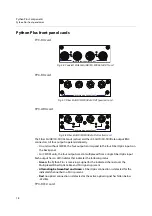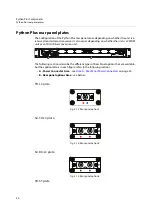
6
About Python Plus
About the Python Plus System
About the Python Plus System
The Python Plus transmitter multiplexes a number of HD/SDI signals into a fiber optic
transport stream. The number of signals can be 4, 8, 12, or 16 – always in multiples of four.
Similarly, the Python Plus receiver de-multiplexes a corresponding number of fiber optic
signals into HD/SDI.
The method of fiber optic signal transmission can use one-for-one pass through conversion
of each HD/SDI signal or CWDM (course wavelength division multiplexing) for up to 16
HD/SDI signals combined into a signal fiber optic cable.
In addition to Python Plus transmitter and receiver models, Transceivers are also available
which allow various combinations of transmit and receive in the same unit. Please see
on page 12 for the model list.
Python Plus units accept electrical digital signals (via BNC), ranging from 19.4 Mbps up to
12 Gbps-uncompressed HD/SDI.
Along with LEDs to indicate the presence of an HD/SDI signal at each BNC input and output,
the Python Plus features an integrated optical power meter for monitoring the received
power for each optical HD/SDI signal. Fiber optical power is measured only at the receiver
end of the signal path.
Figure 1-1 is a conceptual overview of an example Python Plus signal path.
Fig. 1-1: Python Plus Conceptual Overview
The Python Plus also features dual 12
-
18 VDC power inputs for electrical redundancy
.
Up to
3 Gb/s (SDI) or 10 Gb/s (IP) is supported on each optical channel.
The Python Plus handles a wide range of digital video rates. Supported formats include:
• 12 Gb/s HD/SDI: SMPTE 2081
• 6 Gb/s HD/SDI: SMPTE 2082
• 3 Gb/s HD/SDI: SMPTE 424M
Содержание Grass Valley Python Plus
Страница 10: ...10 About Python Plus FCC Part A Manual Notice ...
Страница 13: ...13 Python Plus User Guide Block Diagrams PY3 FRAME PY3 TX G PY3 RX and W4 TX ST Fig 2 1 4 Channels Python Plus ...
Страница 14: ...14 Hardware and Block Diagrams PY3 FRAME PY3 TX G PY3 RX and W4 TX ST ...
Страница 38: ...38 ...







































